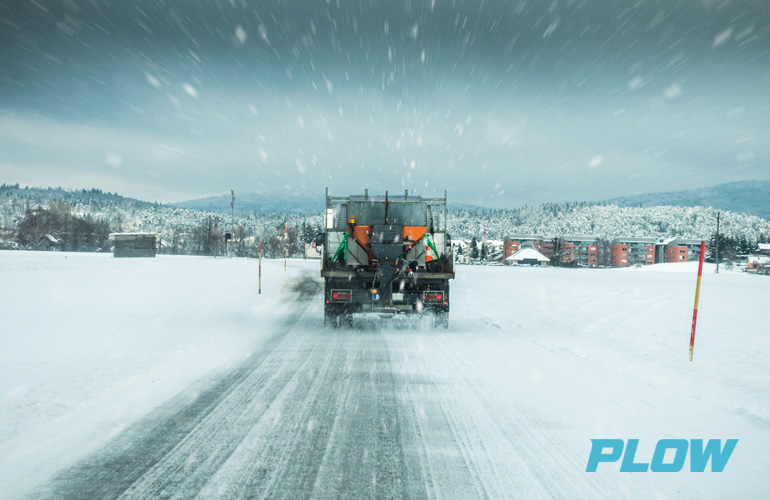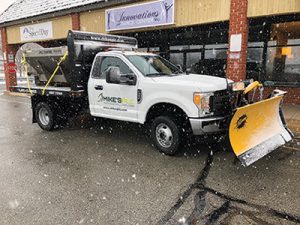



Source: www.TurfMagazine.com
[dropcap]I[/dropcap]t’s a job that’s usually done in the worst of conditions — total darkness, or blinding snow, or a coating of ice, or all at the same time. And the stakes are high. Unlike some lawn and landscape services where aesthetics is a top priority, snow and ice management is all about safety. For contractors, all of this creates a lot of consternation — not only over the work itself, but also the liability that’s involved.
Fortunately, there are things you can do — from carrying the right insurance to wording contracts correctly to keeping detailed records — that help minimize your exposure.

Covering Up
Mike Eisenhart, owner of Mike’s Professional Lawn Care in York, PA, says that a standard general liability policy is enough to cover his firm’s summer landscaping work. But when winter arrives, he adds an additional umbrella policy that covers the additional potential liabilities that come with providing snow and ice management services. “Our premium from November to April goes up a significant amount,” he says. But the potential risks that come from a possible lawsuit resulting from a slip-and-fall (or other incident) make it absolutely essential for contractors to carry substantial insurance coverage. And, Eisenhart points out, most commercial snow removal clients require that sort of coverage anyhow.
In most cases, contractors in northern climates who work year-round should be able to endorse their existing landscaping policy to pick up coverage for snow and ice removal, explains Scott Young, director of small business underwriting at Progressive Insurance. “A commonly available endorsement is Completed Operations Hazard Coverage for Snow Plow Operations. This endorsement will provide complete operations coverage for companies that use vehicles for snow or ice removal to protect them from slip-and-fall claims that may occur after their work is done,” says Young. He adds that certain “higher-hazard plowing (i.e. over the road, large shopping centers, or airports)” may require a more specialized policy.
“Typically, the more snow work that we do, and the bigger the site, the more insurance we have to carry,” says Eisenhart. “When you get into doing big box stores or apartment complexes — places where there is a little more foot traffic and greater chances for a slip and fall — that’s where you really need to cover your butt…. You just can’t play this game without liability insurance.”
Caution With Contracts
Unfortunately, it’s a fact of life in the snow and ice business that your clients are probably going to require you to cover their concerns, as well. “Whether you’re working for a national service provider that subcontracts you to do the work, or you’re working for your own clients, they don’t want it to come back on their insurance,” explains Eisenhart. “So what they want from you as a contractor is to let them be a certificate holder and list them as ‘additionally insured.’” Essentially, that means if someone is injured on the property, it’s going to be the snow contractor (and their insurance company), rather than the property owner, who will be left to deal with any resulting lawsuit or other liability.
In most cases, if you don’t allow the property owner to be listed as additionally insured, you will not be awarded the contract, Eisenhart notes. “That’s something that most commercial clients will require.”
In at least a few places, that is changing though. Josh Ferguson, an attorney with the firm Freeman Mathis & Gary, LLP, has worked with the Accredited Snow Contractors Association (ASCA) to advance tort reform and legislative efforts in various states to help curb some of the lawsuits faced by those working in the industry. Most notable has been an anti-indemnity bill, versions of which have now been passed in three states (Illinois, Colorado, and Connecticut).
“That bill essentially voids, or makes against public policy, the ability of a property owner or property manager to pass their liability onto a snow and ice management contractor,” explains Ferguson.
If the contractor does something wrong — say, forgets to put salt down or doesn’t show up—the property owner can still seek to have the liability placed on the contractor. Yet, under the new bill in those three states, the broad contract language placing all liability on the contractor is now prohibited. Ferguson notes that the effects of these new laws go beyond just protecting contractors to protecting the general public. When contracts are allowed to be written in a way that property owners or managers know they are protected from liability regardless, they might see an incentive to save money by not having the site properly serviced. “And that’s a problem for the people who go to visit these sites,” states Ferguson, noting that several more states are now considering similar legislation.
Regardless of what your state law says, Ferguson advises that “the best thing you can own when looking over contracts is a red pen.” In most cases he’s seen, it has been possible to get at least something changed in the contract language that better protects the contractor. “The most important thing to change is the indemnity provision, to be sure that you’re only going to be responsible for your negligent acts or omissions, and that you’re not going to be on the hook for someone else’s errors,” he stresses.
The contract should contain verbiage making it clear that you, as the contractor, have final discretion on when and how snow and ice will be treated, Eisenhart advises. This can be tricky, he acknowledges. “Some people worry that you’re going to over-service the account. But I explain that if I’m on the hook for a slip-and-fall, then I’m the one who is going to be determining whether we need ice melt product applied. And I’m the one who is watching the weather and knows if we’re going to have run-off and refreeze.”
The bottom line: Be sure to carefully scrutinize all of your maintenance agreements before signing to be sure you understand what you might be liable for. “Contract language can be difficult to interpret, so using a trusted insurance advisor is a best practice,” advises Young. And, he adds, “be transparent with your insurance agent and/or carrier about the type of snow removal work that your business does. Your insurance company and/or agent… can help ensure your business has the right balance of coverage and price.”
Details Matter
Whether it’s summer or winter work, landscapers know that details matter. And, that applies not just out on the job site. Reducing your company’s liability also requires crossing your t’s and dotting your i’s. For example, Ferguson emphasizes that, when it comes to contracts, “you want to make sure the scope of services is well defined.” That means including specifics regarding when and how the site is to be serviced: Is the trigger one inch of snow, or is it a phone call? How quickly do you have to be there? How long do you have to follow-up after an event to monitor and inspect the property?

“When these things aren’t clear in a contract, what happens in a lawsuit is that people say whatever they need to say to protect themselves,” says Ferguson. And conflicting stories often leads to insurance companies simply settling cases, which can lead to higher rates for the contractor. “What an insurance company wants in order to defend a case is a well-defined contract in place, and a contractor who has documentation to show exactly what they did and exactly when.” That means keeping records to show which employee was on site, how much material was put down, what specific parts of the property were serviced, etc. “You need to be able to show what you did at 2:30 a.m. on February 16 three years ago,” says Ferguson. “As defense attorneys, we need that level of detail.” If you have to estimate, he notes, your credibility goes down.
Beginning last year, Eisenhart added dash cameras to all of his company’s snow removal vehicles, mostly to offer protection against simple things, like a car pulling out in front of one of his plows. But camera technology can also offer time- and date-stamped evidence of weather conditions and work performed — just the kinds of details that can make a big difference in a liability case. “Anything you can do to limit the amount of assumed risk that you take on helps,” he states. “And you can’t dispute video evidence.”
It goes without saying that hiring the right employees and providing comprehensive training can reduce the chances of things going wrong on the job. Young says training should begin with a visit, prior to plowing season, to each customer’s location to document and discuss potential areas of concern. “This also allows you to stake curbs and hydrants, if necessary, and get a lay of the land before everything is covered in snow,” he notes.
Then, after the snow comes, “when possible, plow after hours when parking lots are empty and foot traffic is low,” advises Young. He notes that the majority of slip-and-fall losses occur in parking lots, so store entrances and other areas of high pedestrian traffic should be a priority. 
White is based in Vermont and has covered the lawn and landscape industry for more than 20 years. He’s always on the lookout for interesting stories; he can be reached at pwhite@meadowridgemedia.com.
ENSURING YOU’RE INSURED
Scott Young, director of small business underwriting at Progressive Insurance, offers the following guidance for snow and ice contractors who might be new to the industry, or who have questions about exactly what insurances they should be carrying.

General liability coverage with completed operations for snow removal (usually available via endorsement) is the minimum coverage all contractors should carry. This coverage ensures that you’re covered for liability both during and after snow removal work.
A workers’ compensation policy to cover any workplace injuries is a must for contractors who have employees—especially if employees remove snow via shovel.
A commercial auto policy can cover physical damage to company vehicles, as well as liability you may be responsible for as the result of an accident.
Finally, there are several endorsements to these various insurance policies that all contractors might also consider: cyber coverage, if sensitive customer information is collected in the course of business and stored on a computer; and employment practices liability, which provides coverage if the owners of the business are sued by an employee for wrongful termination/hiring, harassment, or other employment related laws.
Do you have a comment? Share your thoughts in the Comments section below or send an e-mail to the Editor at acosgrove@groupc.com
Want to read more about snow and ice management topics?
Looking for updates? Check out all the latest news related to snow and ice management.